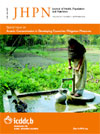
|
The Journal of Health, Population and Nutrition
icddr,b
ISSN: 1606-0997
EISSN: 1606-0997
Vol. 36, No. 1, 2017, pp. 1-9
|
 Bioline Code: hn17026
Bioline Code: hn17026
Full paper language: English
Document type: Research Article
Document available free of charge
|
|
|
The Journal of Health, Population and Nutrition, Vol. 36, No. 1, 2017, pp. 1-9
| en |
Survival analysis of under-five mortality using Cox and frailty models in Ethiopia
Ayele, Dawit G.; Zewotir, Temesgen T. & Mwambi, Hemry
Abstract
Background: The risk of a child dying before reaching 5 years of age is highest in sub-Saharan African countries.
But in Ethiopia, under-five mortality rates have shown a substantial decline.
Methods: For this study, the Cox regression model for fixed and time-dependent explanatory variables was studied
for under-five mortality in Ethiopia. We adapted survival analysis using the Cox regression model with 2011 Ethiopian
Demographic and Health Survey data.
Results: From the results, it was found that under-five children who live in Addis Ababa had a lower hazard (risk) of
death (p value = 0.048). This could be as a result of higher health facilities and living standards in Addis Ababa, compared
to other regions. Under-five children who lived in rural areas had a higher hazard (risk) of death compared to those living
in urban areas. In addition, under-five children who lived in rural areas had 18% (p value = 0.01) more hazard (risk) of
death than those living in urban areas. Furthermore, with older mothers, the chance of a child dying before reaching the
age of 5 is lower.
Conclusion: The chances of a child dying before reaching the age of 5 are less if the mother does not become
pregnant again before the child reaches the age of 5. Therefore, giving birth when older and not becoming pregnant
again before the child reaches the age of 5 is one means of reducing under-five mortality.
Keywords
Hazards; Interaction effect; EDHS; Frailty; Under-five mortality
|
| |
© Copyright 2017 - The Author(s)
Alternative site location: http://www.jhpn.net
|
|
